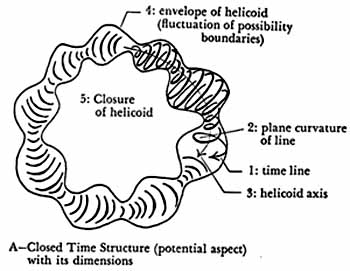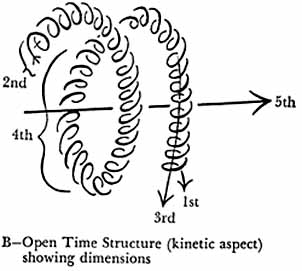Dr. Charles Muses -- a mathematician,
philosopher, and computer scientist who died in 2000 -- was author of Destiny
and Control in Human Systems and The Lion Path. Muses has
developed an approach to astrology couched in the language of systems
theory. In a Thinking Allowed interview, he described the
theoretical principles underlying the methodology he has come to refer
to as chronotopology -- i.e., studying the structure of time. One has a
sense from this discussion that contemporary astrology is, perhaps, a
decadent form of what was once a philosophically well-grounded and noble
pursuit:
MUSES: The hypothesis of chronotopology
is that whether you have pointers of any kind -- ionospheric
disturbances or planetary orbits -- independently of those pointers,
time itself has a flux, a wave motion.
MISHLOVE: In quantum physics there's
this notion that the underlying basis for the physical universe are
probability waves -- nonphysical, nonmaterial waves -- underlying
everything.
MUSES: These waves are standing waves.
Actually the wave-particle so-called paradox is not that bad, when you
consider that a particle is a wave packet, a packet of standing waves.
That's why an electron can go through a plate and leave wavelike
things. Actually our bodies are like fountains. The fountain has a
shape only because it's being renewed every minute, and our bodies are
being renewed. So we are standing waves; we are no exception.
Time is the master control. I will
give you an illustration of that. If you take a moment of time, this
moment cuts through the entire physical universe as we're talking. It
holds all of space in itself. But one point of space doesn't hold all
of time. In other words, time is much bigger than space.
A line of time is then an occurrence,
and a wave of time is a recurrence. And then if you get out from the
circle of time, which Nietzsche saw, the eternal recurrence -- if you
break that, as we know we do, we develop, and then we're on a helix,
because we come around but it's a little different each time.
MISHLOVE: Well, now you're beginning
to introduce the notion of symbols -- point, line, wave, helix, and so
on.
MUSES: Yes, the dimensions of time.
MISHLOVE: Symbols themselves -- words,
pictures -- point to the deeper structure of things, including the
deeper structure of time. I gather that you are suggesting the mind is
part of a nonphysical, mathematically definable reality that can
interface and interact with physical reality, and in which physical
reality is embedded.
MUSES: There can be some things which
are physically effective which are not physical. I can give you an
illustration, a very recondite one, but there is the zero-point energy
of the vacuum. The vacuum is defined in quantum physics as space
devoid of radiation or matter -- no energy, no matter. Yet there is an
inherent energy in there which can be measured -- this is one of the
great triumphs of modern physics -- and that is physically effective.
MISHLOVE: The energy of a pure vacuum.
MUSES: Yes. Yet it obviously is not a
pure vacuum. The so-called savage would say to us, "The room is
empty, and the wind is a magic spirit." We know it is air. So we
are like the savage in saying that the vacuum is empty. There is
something there.
Muses, in effect, has been echoing the
ancient claim of the Primordial Tradition that there is a fundamental
unity between the universal mind and the cosmos itself -- including the
unfolding of time. The structure of the relationship between macrocosm
and microcosm is expressed in mathematical, scientific and mythological
symbols. It is the intuitive grasp of these symbols which is ultimately
the goal of astrology.
Such a system must always be larger and
more enduring than any rational attempt to understand or contain it. If
this perspective of astrology is correct, I would predict that
rationalists will forever shun astrology's pseudoscientific face. And,
ironically, astrology and other "superstitions" will persist
because the yearning human soul never be content with rational
materialism.



